Uworld 19 – Flashcard
Unlock all answers in this set
Unlock answersquestion
1) A 72-year-old woman comes to the office due to persistent headaches, fatigue, and diffuse muscular pain. She has a history of hypertension and osteoarthritis. The patient does not use tobacco, alcohol, or illicit drugs. Her father had a subarachnoid hemorrhage from a ruptured
answer
berry aneurysm. She is treated with prednisone, leading to marked and rapid improvement in her symptoms. Which of the following pathologic processes is most likely responsible for this patient's condition?
question
A) Granulomatous inflammation of the media B) Homogenous acellular thickening of arteriolar walls C) Medial band-like calcifications D) Onion-like concentric thickening of arteriolar walls E) Transmural inflammation with fibrinoid necrosis
answer
A) Granulomatous inflammation of the media
question
Female with ****Headaches and muscle pain*** =
answer
**Temporal Arteritis***
question
***Temporal Arteritis**** =
answer
**Granulomatous inflammation of the Media**
question
what do you see in *Temporal arteritis*?
answer
**Granulomatous inflammation of the Media**
question
2) A 23-year-old woman is brought to the emergency department unconscious after a motor vehicle accident. The patient was texting on her cell phone and was not wearing a seatbelt during the incident. She has no known medical problems and takes no medications.
answer
A linear skull fracture at the junction of the frontal, parietal, temporal, and sphenoid bones is seen on head CT scan. A branch of which of the following arteries is most likely severed in this patient?
question
A) Facial B) Maxillary C) Middle cerebral D) Occipital E) Ophthalmic F) Sphenopalatine
answer
B) Maxillary - Epidural Hematoma
question
***Junction of the frontal, parietal, temporal, and sphenoid bones***
answer
**Pterion**
question
**Middle meningeal artery** is a brach of?
answer
**Maxillary** artery
question
Where does *Middle meningeal artery* come from?
answer
**Maxillary** artery
question
3) A 19-year-old man is admitted with delusions, hallucinations, and disorganized behavior. He is diagnosed with schizophrenia, and the physician writes an order to begin aripiprazole "2.0" mg. The patient mistakenly receives 20 mg aripiprazole instead of 2 mg.
answer
This order is overlooked during the pharmacy review process, and the nurse fails to question it before administering aripiprazole to the patient. Which of the following is the most effective intervention to reduce this type of error?
question
A) Confirm dosage with the patient prior to administration B) Educate physicians to avoid use of trailing zeros C) Employ computerized systems to flag inappropriate medication orders
answer
D) Remind physicians to be careful with decimal point placement E) Require 2 nurses to check medication orders F) Require 2 pharmacists to check all orders
question
B) Educate physicians to avoid use of trailing zeros
answer
do NOT write 2.50 mg, because here the *0* is not needed and they might read it as 250 mg. Instead just write 2.5 mg.
question
4) A 43-year-old man is evaluated for progressive neuropsychiatric symptoms. A year ago, he began feeling depressed and having hallucinations. Five months later, he developed intermittent paresthesias and progressively worsening choreiform movements, myoclonus, and ataxia.
answer
These symptoms have not improved despite multiple hospitalizations; an extensive workup has been unrevealing. The patient is a slaughterhouse worker with extensive exposure to bovine offal.
question
As part of the evaluation for prion disease, a tissue sample digested with protease is processed via gel electrophoresis and transferred to filter paper. Antibodies to a specific prion protein are added to the filter.
answer
Next, a marked protein that combines with the antibody-protein complex is used to determine whether the test is positive. Which of the following best describes this test?
question
A) Microarray B) Northern blot C) Southern blot D) Southwestern blot E) Western blot
answer
E) Western blot Protein = Western blot
question
5) A 68-year-old man comes to the office due to several weeks of progressive exertional dyspnea and lower extremity edema Past medical history is significant for non-Hodgkin lymphoma, which is in remission after chemotherapy 8 years ago.
answer
On examination, he has bibasilar lung crackles and 1+ bilateral lower extremity edema. Echocardiography reveals biventricular dilation and a left ventricular ejection fraction of 35%. Stress myocardial perfusion scan is negative for inducible ischemia.
question
After initial stabilization, long-term use of which of the following medications will most likely improve survival in this patient?
answer
A) Amiodarone B) Amlodipine C) Carvedilol D) Digoxin E) Diltiazem F) Flecainide G) Furosemide
question
C) Carvedilol
answer
Drugs for preventing *Morbidity* **SABA** - *S*pironolactone - *A*CE inhibitors - *B*eta-blocker - *A*ngiotensin Receptor Blockers
question
6) A 2-month-old boy is found unresponsive in his crib. He had previously been well and had a normal physical examination at his 2- month visit approximately 1 week earlier. An autopsy is performed to determine the cause of death.
answer
Pathologist concludes infant died of sudden infant death syndrome. The autopsy also shows an incidental finding of bicuspid aortic valve. If patient had survived, he would have been at greatest risk for which of the following events?
question
A) Aortic dissection in his 30s B) Aortic stenosis in his 50s C) Atrial fibrillation in his 40s D) Endocarditis in his 20s E) Severe aortic stenosis in infancy F) Ventricular arrhythmia in childhood
answer
B) Aortic stenosis in his 50s
question
**Bicuspid aortic valve*** leads to?
answer
***Aortic stenosis**
question
what does *Bicuspid aortic valve* lead to?
answer
**Aortic stenosis**
question
7) A 34-year-old electric company worker comes to the physician with a skin rash on his right leg. He has not eaten any new foods or changed detergents, soaps, or lotions. On further questioning, the patient recalls that he recently worked on a repair job in an unmaintained, wooded area.
answer
He had atopic dermatitis as a child but no other significant illnesses. On physical examination, he appears uncomfortable and is constantly scratching his leg. His lungs are clear bilaterally and his heart sounds are normal.
question
What is responsible for tissue damage? a) Basophils b) Eosinophils c) Mast cells d) Neutrophils e) Plasma cells f) T lymphocytes
answer
f) T lymphocytes Type 4 Hypersensitivity = Poison Ivy
question
8) A 43-year-old man prospecting for gold in Arizona becomes stuck in the desert after his truck breaks down. He brought a large supply of water with him but only a few granola bars as food. After 3 days, he is able to flag down a passing vehicle and obtain transportation to the nearest
answer
settlement. During this ordeal, his liver begins to synthesize large quantities of glucose from source molecules such as alanine, lactate, and glycerol.
question
As part of this process, phosphoenolpyruvate is formed from oxaloacetate in a reaction that requires a specific nucleoside triphosphate as a cofactor. Which of the following reactions directly synthesizes this cofactor?
answer
A) A B) B C) C D) D E) E
question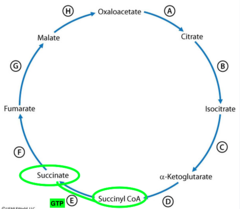
Where is *GTP* synthesized?

answer
from *Succinyl CoA* to *succinate*
question
9) A 45-year-old man presents to the emergency department with a two-day history of dyspnea, orthopnea, and ankle swelling. This morning, he developed nausea, vomiting, and a headache. There is pulmonary crackles and bilateral pitting edema up to his knees.
answer
A nitroprusside infusion is promptly initiated. Which of the following pairs of left ventricular pressure/volume relationships best represents the effects of nitroprusside?
question
10) A 74-year-old woman comes to the emergency department due to 2 days of left leg pain and numbness. She has a history of atrial fibrillation and hypertension. Her left lower limb is pale and cold to palpation below the knee. Arterial Doppler ultrasound shows an occluding
answer
thrombus, and a left femoral embolectomy is performed. Post-procedure dorsalis pedis and posterior tibial pulses become palpable. Several hours later, the patient begins to experience severe left calf pain. On repeat examination, the left calf is swollen, tense, and tender, and the pain worsens
question
with dorsiflexion of the left foot. The distal pulses are also absent. The physician suspects injury of the reperfused muscles in part due to overproduction of reactive oxygen species. Which of the following enzymes is most likely to help neutralize these toxic molecules?
answer
A) Cytochrome oxidase B) Cytochrome P450 C) Myeloperoxidase D) NADPH oxidase E) Superoxide dismutase
question
E) Superoxide dismutase
answer
**Converts 02- to H2O2** - *Sequesters free radicals*
question
11) A physician caring for numerous patients on a busy service is called at 3:00 AM by the nursing staff to inform him that a patient he admitted for chest pain has developed acute-onset watery diarrhea. During the evaluation, the patient tells the physician that this began a few hours after
answer
she drank "a big jug of clear watery stuff' that the nurse gave to her. In reviewing her chart, the physician discovers that he mistakenly prescribed an electrolyte bowel preparation for the patient with chest pain rather than for the intended patient, who has a gastrointestinal
question
bleed and was scheduled for a colonoscopy in the morning. The patient is in no distress and says that she actually feels better as she had not had a bowel movement in the last 2 days. Which of the following is the most appropriate action by the physician?
answer
A) Consult risk management regarding whether to inform the patient of the error B) Disclose the error with an explanation and apology C) Do not disclose the error as the patient was not harmed and may have benefited from the intervention
question
D) Do not disclose the error but ensure that the patient is not billed for the bowel preparation E) Monitor the patient closely and disclose the error only if the patient complains of an adverse effect from the bowel preparation
answer
B) Disclose the error with an explanation and apology
question
12) A 64-year-old man comes to the office due to skin blisters on his trunk and groin. The patient has had itching for the past several weeks and developed the blisters a week ago. He has a history of hypertension and osteoarthritis. He received zoster vaccine at age 60.
answer
Examination shows numerous 0.5 to 3 cm bullous skin lesions. Skin biopsy is performed and shows the findings in the image below. Which of the following is the most likely diagnosis?
question
a) Bullous pemphigoid b) Contact dermatitis c) Dermatitis herpetiformis d) Lichen Planus e) Pemphigus vulgaris
answer
a) Bullous pemphigoid
question
**Dermal-Epidermal splitting***
answer
**Bullous pemphigoid**
question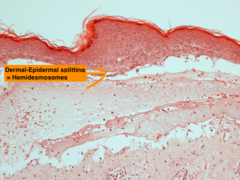
What do you see in **Bullous pemphigoid**?

answer
**Dermal-Epidermal splitting***
question
13) Laboratory animals deprived of folic acid experience a marked increase in marrow erythroid precursor cell production. Subsequently, many of these erythroid precursor cells undergo apoptosis without further maturation.
answer
Provision of which of the following supplements would reduce erythroid precursor cell apoptosis in these animals?
question
A) Homocysteine B) Cytosine C) Thymidine D) Cobalamin E) Glutamine
answer
C) Thymidine
question
*Thymidine* is involved in DNA synthesis.
answer
*Thymidine* prevents apoptosis of Erythroid precursor cells
question
**Folate deficiency** will lead to?
answer
decrease in *Thymidine* levels
question
*Lack of thymidine* causes?
answer
*Apoptosis* of erythroid precursor cells causing *Megaloblastic anemia*
question
*Apoptosis* of erythroid precursor cells causes
answer
*Megaloblastic anemia*
question
*Lack of thymidine* causes?
answer
*Apoptosis*
question
**Folate deficiency** will cause?
answer
decrease in *Thymidine* levels
question
14) A 23-year-old male was involved in a motor vehicle accident. He lost consciousness at the scene but recovered by the time EMS arrived. He was alert and awake in the ambulance but lost consciousness soon after arriving to the ER. Skull x-ray shows a fracture of the temporal bone.
answer
This patients symptoms are most likely caused by blood accumulated between the.
question
A) Aponeurosis and periosteum B) Periosteum and bone C) Bone and dura mater D) Dura mater and arachnoid E) Arachnoid and pia mater F) Pia mater and brain surface
answer
C) Bone and dura mater - Epidural hematoma
question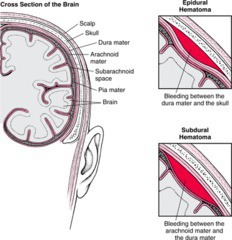
**Epidural Hematoma**

answer
**Bone and dura mater**
question
15) A 29-year-old Caucasian female complains of decreased vision and pain around her eye, which is aggravated by eye movement. Several months later she is found to have an intention tremor of her left arm. This patient's condition is most likely caused by:
answer
A) Bacterial infection B) Vascular disease C) Trauma D) Autoimmune disease E) Inherited metabolic disease F) Intoxication
question
D) Autoimmune disease
answer
Decreased vision intention tremor - Multiple sclerosis
question
16) A 46-year-old man comes to the emergency department with chest pain that began 30 minutes ago. He describes the pain as a tight, squeezing sensation that radiates to the left arm. He also has increased sweating and nausea. The patient's ECG shows multiple- lead ST-segment
answer
elevation, and cardiac troponin levels are high. He has no known history of cardiac disease. He has a history of alcohol and cocaine abuse. As the patient finishes undergoing emergency cardiac catheterization, the physician is approached by a distraught woman who says
question
she is his wife and asks about his condition. She says, "I am so worried; please tell me if my husband is okay." Which of the following is the most appropriate course of action? A) Discuss the patient's medical information with the woman due to the seriousness of his condition
answer
B) Discuss the patient's status with the woman only if she has appropriate identification C) Explain to the woman that no information can be disclosed without permission
question
D) Explain to the woman that the patient's status cannot be disclosed as there is no way to be sure she is his spouse E) Inform the woman that the patient is stable, but that she will have to wait until he can give permission to share any details
answer
***E) Inform the woman that the patient is stable, but that she will have to wait until he can give permission to share any details***
question
17) A 36-year-old woman comes to the office due to firm, nontender swelling of her right cheek for the past 4 months. The patient has had no fever, runny nose, sore throat, or cough. She drinks a glass of wine with dinner on most nights but does not use tobacco.
answer
There is fullness of the preauricular space on the right side. An MRI of the region identifies a 22-cm mass in the right parotid gland, and a follow-up core needle biopsy shows the lesion to be neoplastic. If left untreated, this patient is most likely to develop which of the following?
question
A) Bitemporal hemianopsia B) Facial droop C) Facial numbness D) Hoarseness E) Horner syndrome F) Strabismus
answer
B) Facial droop Facial nerve = Droop
question
Facial *Nerve* damage causes?
answer
Facial *Droop*
question
Facial *Nerve* damage causes?
answer
Facial *Droop*
question
18) A 54-year-old man comes to the office due to episodic burning substernal chest pain. His pain increases with activity and improves with rest. The patient has a history of hypertension and hyperlipidemia. He has smoked a pack of cigarettes daily for the past 30 years.
answer
His blood pressure is 140/85 mm Hg and pulse is 76/min. Cardiac auscultation reveals a S4 heart sound. Lung and abdominal examinations are unremarkable. An ECG at rest shows left ventricular hypertrophy.
question
A myocardial perfusion scan reveals inducible ischemia of the inferior surface of the heart. Which of the following coronary arteries is most likely occluded in this patient?
answer
A) Left anterior descending coronary artery B) Left circumflex coronary artery C) Left main coronary artery D) Right coronary artery E) Right marginal branch
question
**Inferior surface of heart**
answer
***RCA**
question
19) A 72-year-old man is brought to the emergency department due to involuntary movements of his right arm that started several hours ago. He was watching television when his arm "threw the remote control across the room."
answer
His past medical history is significant for long-standing hypertension and diabetes mellitus. The patient does not use alcohol, tobacco, or illicit drugs. Physical examination shows wild, large-amplitude, flinging movements affecting the proximal muscles of his right arm.
question
Which of the following areas of the brain is most likely injured in this patient? A) Caudate nucleus B) Internal capsule C) Lentiform nucleus D) Substantia nigra E) Subthalamic nucleus F) Ventral posterior thalamus
answer
E) Subthalamic nucleus - Hemibalissmus *Large flinging movements of the arm*
question
20) A scientist is conducting research to discover novel drug targets for antiretroviral agents against HIV. A blood sample from a 22-year- old man with HIV is being analyzed in the laboratory.
answer
Purified CD4+ T cells are extracted. Using molecular tracing techniques, the scientist follows a viral HIV protein that is synthesized in the patient's T cells.
question
She finds that the protein becomes glycosylated before being proteolytically cleaved into 2 smaller proteins in the endoplasmic reticulum and Golgi apparatus. Based on this data, which of the following best describes the function of these 2 newly formed HIV proteins?
answer
A) Viral DNA integration into the host genome B) Viral DNA synthesis from RNA template C) Viral polyprotein cleavage D) Virion attachment to the target cells E) Virus-induced cell apoptosis
question
*Env* protein is *Glycosylated* into gp 120 and gp 40 (Glycoprotein)
answer
How do you get these *Glycoproteins* (gp 120 and gp 40)? Via *glycosylation* of *Env* protein.
question
What is the function of *Gp 120* and *Gp 40* ?
answer
*Virion attachment to the target cells*
question
Protein becomes glycosylated before being proteolytically cleaved into 2 smaller proteins?
answer
Protein - *Env* Glycosylated smaller proteins (Glycoproteins - Gp 120 - Gp 40
question
What is the function of *Gp 120* and *Gp 40* ?
answer
*Virion attachment to the target cells*
question
21) A 5-year-old boy is brought to the ER with breathing difficulty, White blood cell count is 23,000/mm with many band forms. There is epiglottis, dysphagia, drooling and fever. Laryngoscopy shows a swollen and cherry-red pharynx.
answer
A) Traveled recently B) Missed vaccination C) Was stung by a bee D) Has penicillin allergy E) Has characteristic family history
question
B) Missed vaccination
answer
*Epiglottitis* - Haemophilus Influenzae
question
22) A 55-year-old man comes to the office due to malaise and cough over the past 2 months. He describes yellow sputum production with occasional streaks of blood. The patient smokes a pack of cigarettes daily and has a history of alcohol abuse with prior episodes of binge drinking.
answer
Examination shows poor dentition with dental caries, gingivitis, and enlarged submandibular lymph nodes. Coarse rhonchi are heard during auscultation of the right lung. Chest CT scan reveals an extensive right lung consolidative process with air bronchograms.
question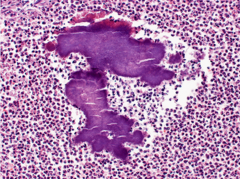
Bronchoscopy is performed, and a lung biopsy specimen shows the findings in the image below.

answer
What is diagnosis? a) Actinomycosis b) Adenocarcinoma c) Mycormycosis d) Sarcoidosis e) Tuberculosis
question
a) Actinomycosis
answer
**Sulphur granules**
question
23) A 62-year-old man is brought to the emergency department due to the sudden onset of high fever and shaking chills. Twelve hours before presentation, he had experienced shortness of breath and cough. The patient has smoked 1 pack of cigarettes daily for 40 years.
answer
His vaccination record is unknown. Examination shows dullness to percussion over the left side of the chest. Chest x-ray reveals consolidation in the left upper lobe. Gram stain of the sputum shows gram-positive diplococci. Small alpha-hemolytic colonies grow in a blood agar plate.
question
Which of the following is the major virulence factor of the bacteria causing the disease in this patient? A) Endotoxins B) Flagella C) Glutamic acid capsule D) M protein E) Polysaccharide capsule
answer
E) Polysaccharide capsule - Streptococcus pneumoniae
question
24) A 45-year-old woman is brought to the emergency department after a generalized tonic-clonic seizure. She reports no prior history of seizures, but she has noticed right arm weakness over the last week. Her family history is significant for her mother's death from skin cancer.
answer
Physical examination shows a skin lesion measuring 13 mm on her back, as shown in the image below. This lesion most likely originated from which of the following embryologic derivatives?
question
a. endoderm b. Mesoderm c. Neural crest d. Neuro-ectoderm e. Surface ectoderm
answer
c. Neural crest - *Melanoma*
question
25) The following vignette applies to the next 2 items. A 24-year-old woman comes to the office for an infertility evaluation. She has had irregular menstrual cycles for the past 5 years, with menstrual periods every 2-3 months on average.
answer
Her past medical history is notable for an appendectomy 5 years ago but is otherwise not significant. The patient takes no medications. Her blood pressure is 125/86 mm Hg and pulse is 72/min. BMI is 33 kg/m2.
question
Physical examination shows facial acne and excessive hair growth on the upper lip and chin. Which of the following is the most likely pathologic finding in this patient?
answer
A) Atrophic endometrium B) Bilateral adrenal atrophy C) Enlarged ovaries D) Pituitary adenoma E) Polycystic kidneys
question
C) Enlarged ovaries
answer
**PCOS**
question
**PCOS**
answer
**Enlarged ovaries**
question
26) The patient wishes to discuss treatment options. Which of the following treatment mechanisms best addresses her infertility problem?
answer
A) 11 -beta-hydroxylase antagonism B) Androgen receptor antagonism C) Dopamine receptor agonism D) Estrogen receptor modulation E) Progesterone supplementation
question
D) Estrogen receptor modulation
answer
For treating *Infertility* in PCOS.
question
How to treat *Infertility* in PCOS?
answer
**Estrogen receptor modulation**
question
27) A 63-year-old man with a history of chronic obstructive pulmonary disease comes to the physician for a follow-up visit. He uses a tiotropium inhaler daily and his pulmonary symptoms are sufficiently controlled.
answer
During a previous visit, he was counseled on the benefits of smoking cessation. He reports that despite trying he has been unable to stop smoking due to overwhelming cravings.
question
The physician prescribes a drug that reduces nicotine cravings while decreasing the pleasurable effects of cigarettes and other tobacco products. Which of the following medications was most likely prescribed to the patient?
answer
A) Clonazepam B) Fluoxetine C) Nicotine patch D) Topiramate E) Varenicline
question
E) Varenicline
answer
**Decreases pleasurable effects of cigarettes**
question
What *decreases pleasurable effects of cigarettes**?
answer
**Varenicline**
question
28) A 43-year-old man is evaluated for occasional palpitations provoked by anxiety. The patient describes a sudden-onset pounding sensation in the chest followed by lightheadedness and shortness of breath. He has never had syncope.
answer
After initial evaluation, he is treated with verapamil and reports marked improvement in the frequency of palpitation episodes. The tracing below shows the electrical activity of a specific type of cardiac cell in this patient's heart.
question
Which of the following effects would verapamil administration most likely have on these cells?
answer
A) Decreased excitation and contraction coupling B) Lowered threshold potential C) Reduced refractory period D) Shortened action potential duration E) Slowed diastolic depolarization
question
E) Slowed diastolic depolarization
answer
**Calcium channel blockers**
question
what does *Calcium channel blocker* do?
answer
*Slowed diastolic depolarization*
question
29) A 54-year-old man comes to the physician with recent-onset mild headaches and left leg weakness. examination are shown in the image below.

answer
which of the following inheritance patterns is this patient's disorder most likely to exhibit?
question
a) Genomic imprinting b) Mitochondrial c) Multifactorial d) Single-gene autosomal dominant e) Single-gene autosomal recessive f) Single-gene X-linked
answer
d) Single-gene autosomal dominant *Neurofibromatosis* is *autosomal dominant*
question
30) A 62-year-old woman comes to the office for follow-up of osteoporosis. She was diagnosed after developing a vertebral compression fracture a year ago and has been taking alendronate since.
answer
Follow-up quantitative x-ray densitometry reveals slightly increased bone density compared to the baseline scan from a year ago. Which of the following is structurally similar to the medication used to treat this patient's bone disease?
question
A) Citrate B) Estrogen C) Hydroxyproline D) Parathyroid hormone E) Pyrophosphate F) Tumor necrosis factor
answer
E) Pyrophosphate
question
Bis*phosph*onate is similar to?
answer
pyro*phosphate*
question
How to remember that bis*phosphate* is similar to pyro*phosphate* ?
answer
Both have *Phosphate* in them
question
**Bisphosphonate** is similar to?
answer
*Pyrophosphate*
question
31) A 5-year-old boy receiving treatment for allergic rhinitis has flushed cheeks and dilated pupils on physical exam. best explained by: These findings are best explained by:
answer
A) Antagonism of HI receptors B) Antagonism of H2 receptors C) Antagonism of muscarinic receptors D) Antagonism of nicotinic receptors E) Stimulation of alpha 1-adrenoreceptors
question
**Flushed skin, Dilated pupils**
answer
**Antagonism of muscarinic receptors**
question
32) A 54-year-old man is transferred to the hospital from his cardiologist's office due to atrial fibrillation with rapid ventricular response. His symptoms began 24 hours earlier with palpitations, lightheadedness, and chest tightness.
answer
The patient has had similar episodes several times during the last year. Past history is notable for mitral valve repair 3 years ago for severe symptomatic mitral regurgitation.
question
The patient undergoes direct current cardioversion due to worsening hemodynamic instability, with resolution of the arrhythmia and all associated symptoms.
answer
He is considered for long-term amiodarone therapy to prevent future arrhythmic episodes. Which of the following should be tested before initiating this medication?
question
A) 24-hour urinary cortisol B) 24-hour urinary metanephrines C) Oral glucose tolerance test D) Serum prolactin E) Serum testosterone F) Serum TSH
answer
F) Serum TSH - Amiodarone can cause *Hyper* or *Hypo*thyroidism
question
33) A newborn girl is admitted to the neonatal intensive care unit with jaundice, hepatomegaly, and generalized edema She was born by vaginal delivery to a 32-year-old woman, gravida 2, para 2, who received minimal prenatal care. The infants laboratory results show a hemoglobin
answer
level of 6 g/dL and a positive direct Coombs test. A peripheral blood smear shows many nucleated erythrocytes. The infant has significant respiratory distress due to pleural effusions and ascites and dies soon after birth.
question
Autopsy shows areas of extramedullary hematopoiesis in many tissues. Which of the following is the most likely cause of this patients condition?
answer
A) Abnormal hemoglobin polymerization B) Absence of alpha globin chains C) Erythrocyte opsonization by maternal antibodies D) Glucose-6-phosphate dehydrogenase deficiency E) Red blood cell lysis by fetal antibodies
question
C) Erythrocyte opsonization by maternal antibodies
answer
**Hemolytic disease** of the newborn
question
**Positive direct coomb's test**
answer
**Hemolytic disease** of the newborn
question
**Positive direct coomb's test** **Extramedullary Hematopoiesis** **Anemia** **Reticulocytes/ Nucleated erythrocytes**
answer
**Hemolytic** disease of the newborn
question
Why is there *extramedullary hematopoiesis* in this question?
answer
Because *Anemia* due to Hemolysis triggers *extramedullary hematopoiesis*
question
*Hemolysis* of newborn is triggered by?
answer
*IgG*
question
what do you see **Hemolytic** disease of the newborn
answer
***Erythrocyte opsonization by maternal antibodies***
question
34) A 58-year-old airline captain comes to the office after he was found to have abnormal vision testing during a pilot medical certification examination. The patient feels well and has no ocular symptoms. Vision testing shows normal visual acuity but moderate loss of peripheral vision in both eyes.
answer
Results of the funduscopic examination are shown in the image below
question
He is started on Latanoprost eyedrops. What is mechanism of action of this medication?
answer
a) decreased bicarbonate formation in ciliary body b) decreased formation of abnormal blood vessels in retina c) decreased secretion of aqueous humour d) increased outflow of aqueous humor e) vasoconstriction in ciliary body
question
d) increased outflow of aqueous humor
answer
T- Trabeculae E- Excretion M- Muscuranic agonists P- Prostaglandin agonist C- Ciliary epithelium A- Alpha- agonist/ Acetazolamide B- Beta-blockers S- Secretion
question
**Latanoprost**
answer
***increased outflow of aqueous humor***
question
35) A 37-year-old man comes to the emergency department due to blood-tinged vomiting and abdominal discomfort. Six months ago, he lost his job as an investment banker and began drinking large amounts of whiskey on a daily basis. He has since been hospitalized several times
answer
with alcohol intoxication. His temperature is 36.7 C (98 F), blood pressure is 110/70 mm Hg, pulse is 84/min, and respirations are 18/min. Physical examination shows a firm, enlarged liver. Peripheral blood smear results show neutrophils with 6-8 nuclear lobes.
question
Which of the following is the most likely explanation for this latter finding? A) Blood lipid abnormality B) Chronic blood loss C) Cobalamin deficiency D) Folate deficiency E) Hypothyroidism F) Myelodysplasia
answer
D) Folate deficiency
question
***Alcoholics*** =
answer
***Folate deficiency**
question
36) In an experiment, laboratory animals are subjected to a toxic insult that specifically targets the protein kinesin. Which of the following is most likely to be absent from tissues on histological examination as a result?
answer
A) Nissl substance in pyramidal neurons B) Secretory vesicles in nerve terminals C) T-tubules in skeletal muscle cells D) Desmosomes in epithelial lining cells E) Microvilli in intestinal epithelial cells
question
**Kinesin & Dynein**
answer
involved in *transport of neurotransmitters* contained in *vesicles* towards the *synapse*
question
What is function of *Kinesin & Dynein* ?
answer
Transport *Neurotransmitters* toward synaptic vesicles
question
37) A 50-year-old woman with a history of systemic lupus erythematosus is admitted to the hospital with fever, chills, and burning pain when urinating. She quickly becomes hypotensive despite aggressive resuscitation. Urine and blood cultures grow Gram-negative rods.
answer
One hour after admission, she starts bleeding from venipuncture sites. Laboratory results are as follows.
question
Which of the following is the most likely diagnosis? A) Immune thrombocytopenic purpura B) Thrombotic thrombocytopenic purpura C) Disseminated intravascular coagulation D) Von hillenbrand disease E) Autoimmune hemolytic anemia
answer
C) Disseminated intravascular coagulation
question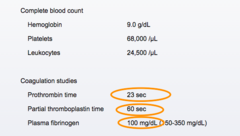
**Increase PT** **Increase PTT** **Decrease Fibrinogen**

answer
*Disseminated intravascular coagulation*
question
38) 400 women aged 20-35 coming for routine check-up are asked about their smoking status. 40% of the women are smokers. Over the next ten years, 25 smokers and 24 non-smokers developed breast cancer. Which of the following best describes the study design?
answer
A) Prospective cohort study B) Retrospective cohort study C) Case-control study D) Cross-sectional study E) Randomized clinical trial
question
A) Prospective cohort study
answer
People being followed for *10 years*
question
39) A 74-year-old man comes to the office due to several months of choking spells, dysphagia, and cough. He has also had recurrent episodes of pneumonia. His other medical problems include hypertension and osteoarthritis. Blood pressure is 130/70 mm Hg. The patient has foul-
answer
smelling breath, but his oropharyngeal and neck examinations are normal. Cardiopulmonary examination is also normal. A barium swallow study is performed and reveals an abnormality in the upper esophagus, as shown in the image below.
question
What is the cause of the symptoms? a) Cricopharyngeal motor dysfunction b) Degenerative changes of the myenteric plexus c) Increased intraluminal pressure in the stomach d) Scarring and traction of esophagus
answer
a) Cricopharyngeal motor dysfunction - Zenker's Diverticulum
question
*Zenker's Diverticulum*
answer
*Cricopharyngeal motor dysfunction*
question
40) A 34-year-old man is brought to the emergency department after being involved in a motor vehicle accident. He suffered blunt abdominal trauma and bilateral femur fractures. He has no significant past medical history. His blood pressure is 80/40 mm Hg and pulse is 110/min.
answer
During resuscitation, he receives several units of packed red blood cells. Once stabilized, the patient begins complaining of a tingling sensation in his toes and fingers. His serum calcium level is noted to be 7.2 mg/dL.
question
Which of the following is the most likely cause of this patient's current symptoms? A) Increased renal tubular secretion of calcium B) Calcium chelation by a substance in the transfused blood
answer
C) Electrolyte leakage from red blood cells during pre-transfusion storage D) Antibody-mediated red blood cell membrane damage E) Parathyroid gland suppression due to fluid overload
question
B) Calcium chelation by a substance in the transfused blood
answer
***Citrate** chelates *Calcium*



